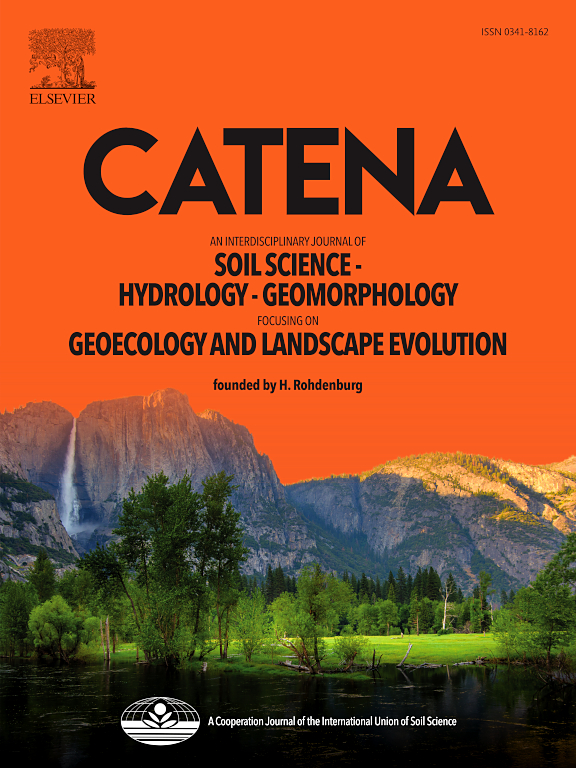Effect of intercropping with forage soybean on the rhizosphere soil nutrients of tea plants
IF 5.4
1区 农林科学
Q1 GEOSCIENCES, MULTIDISCIPLINARY
引用次数: 0
Abstract
Intercropping agriculture has important theoretical and practical significance for solving many problems faced by intensive tea orchards. Forage legumes have great advantages in reducing fertilizer use to increase fertilizer efficiency. Currently, intercropping with legumes has certain effects on improving the environment of tea orchards and tea quality. However, these methods are often not comprehensive enough because the effects of the rhizosphere on the soil fertility of tea plants are frequently ignored. Therefore, four types of planting patterns were tested: monoculture Tieguanyin tea plant (MT), Laredo forage soybean (Glycine max Linn.) no barrier intercropping with tea (IT), plastic partition intercropping with tea (PPIT), and net partition intercropping with tea (NPIT). Nutrient uptake by tea plant roots mediated by forage legumes according to a noninvasive microtest (NIT) showed that the uptake rates of NO3– and NH4+ fluxes increased by 95.91 % and 132.33 %, respectively (P < 0.05). The determination of amino sugars in different tea rhizosphere soils by GC-MS revealed that 6.25-fold more amino sugars were enriched in the rhizosphere. Al speciation distribution analysis revealed that rhizosphere effects shifted exchangeable Al to organic-bound forms, reducing exchangeable Al by 28.5 % and increasing organic Al by 12.7 % (both P < 0.001). Intercropping significantly enhanced tea rhizosphere soil enzyme activity, including 29.80 % sucrase, 171.40 % cellulase, 40.30 % urease and 62.40 % peroxidase. It also had greater 12.50 % MBC, 38.80 % MBN and 17.80 % MBP than those in monocultural tea. Reducing exchangeable Al3+ accumulation on soil aggregates enhanced CEC and alkalinity, boosting soil buffering capacity to alleviate tea rhizosphere acidification. The rhizosphere effect increased the temporal stability of the fertility of the rhizosphere of tea plants. These findings will help us better understand the effect of the rhizosphere on soil fertility and provide a solid theoretical basis for tea cultivation and management.
饲用大豆间作对茶树根际土壤养分的影响
间作农业对解决集约化茶园面临的诸多问题具有重要的理论和现实意义。饲用豆科植物在减少肥料用量、提高肥料效率方面具有很大的优势。目前,豆科作物间作对改善茶园环境和茶叶品质有一定的效果。然而,这些方法往往不够全面,因为根际对茶树土壤肥力的影响往往被忽视。因此,试验了4种种植模式:单作铁观音茶树(MT)、拉雷多饲用大豆(Glycine max Linn.)无屏障间作(IT)、塑料隔断间作(PPIT)和净隔断间作(NPIT)。无创微试验(NIT)表明,饲用豆科植物介导茶树根系对养分的吸收,NO3 -和NH4+通量的吸收率分别提高了95.91%和132.33% (P <;0.05)。用气相色谱-质谱法测定不同茶叶根际土壤中氨基糖含量,发现根际土壤中氨基糖含量是根际土壤的6.25倍。铝形态分布分析表明,根际效应使可交换性铝转变为有机结合形式,可交换性铝减少28.5%,有机铝增加12.7% (P <;0.001)。间作显著提高了茶叶根际土壤酶活性,其中蔗糖酶活性为29.80%,纤维素酶活性为171.40%,脲酶活性为40.30%,过氧化物酶活性为62.40%。MBC 12.50%, MBN 38.80%, MBP 17.80%,均高于单株茶树。降低土壤团聚体交换性Al3+积累,提高土壤CEC和碱度,增强土壤缓冲能力,缓解茶根际酸化。根际效应增加了茶树根际肥力的时间稳定性。这些发现将有助于我们更好地了解根际对土壤肥力的影响,并为茶叶种植和管理提供坚实的理论依据。
本文章由计算机程序翻译,如有差异,请以英文原文为准。
求助全文
约1分钟内获得全文
求助全文
来源期刊

Catena
环境科学-地球科学综合
CiteScore
10.50
自引率
9.70%
发文量
816
审稿时长
54 days
期刊介绍:
Catena publishes papers describing original field and laboratory investigations and reviews on geoecology and landscape evolution with emphasis on interdisciplinary aspects of soil science, hydrology and geomorphology. It aims to disseminate new knowledge and foster better understanding of the physical environment, of evolutionary sequences that have resulted in past and current landscapes, and of the natural processes that are likely to determine the fate of our terrestrial environment.
Papers within any one of the above topics are welcome provided they are of sufficiently wide interest and relevance.
 求助内容:
求助内容: 应助结果提醒方式:
应助结果提醒方式:


